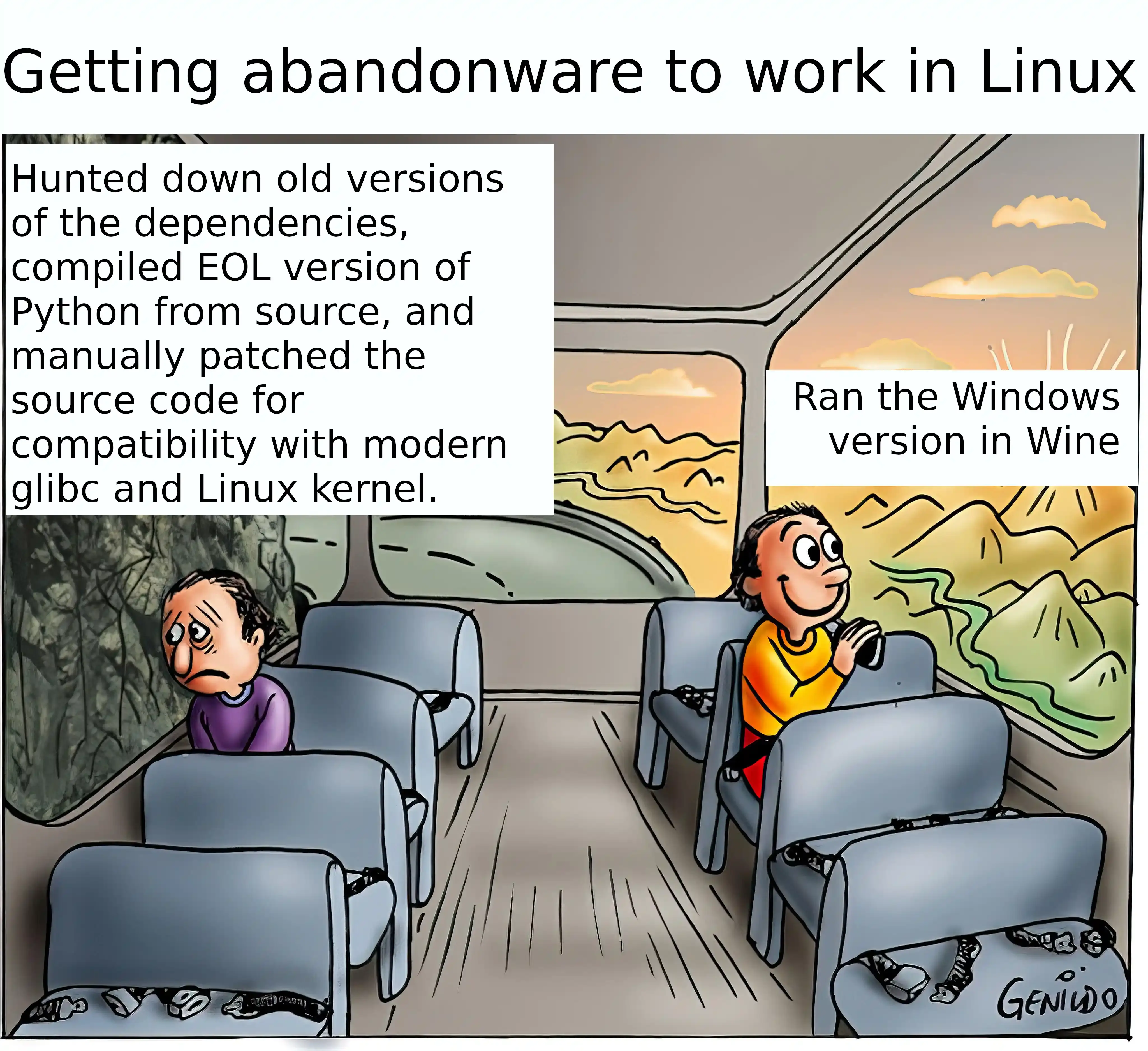this post was submitted on 23 Jan 2024
535 points (98.5% liked)
linuxmemes
21226 readers
144 users here now
Hint: :q!
Sister communities:
- LemmyMemes: Memes
- LemmyShitpost: Anything and everything goes.
- RISA: Star Trek memes and shitposts
Community rules (click to expand)
1. Follow the site-wide rules
- Instance-wide TOS: https://legal.lemmy.world/tos/
- Lemmy code of conduct: https://join-lemmy.org/docs/code_of_conduct.html
2. Be civil
- Understand the difference between a joke and an insult.
- Do not harrass or attack members of the community for any reason.
- Leave remarks of "peasantry" to the PCMR community. If you dislike an OS/service/application, attack the thing you dislike, not the individuals who use it. Some people may not have a choice.
- Bigotry will not be tolerated.
- These rules are somewhat loosened when the subject is a public figure. Still, do not attack their person or incite harrassment.
3. Post Linux-related content
- Including Unix and BSD.
- Non-Linux content is acceptable as long as it makes a reference to Linux. For example, the poorly made mockery of
sudoin Windows. - No porn. Even if you watch it on a Linux machine.
4. No recent reposts
- Everybody uses Arch btw, can't quit Vim, and wants to interject for a moment. You can stop now.
Please report posts and comments that break these rules!
founded 1 year ago
MODERATORS
you are viewing a single comment's thread
view the rest of the comments
view the rest of the comments

One day someone's posts how all Linux programs run forever and Windows creates abandonware
Another day someone complains about the Linux version of his program not tuning anyone so he has to use the Windows version
I'm not sure what's going on anymore
In the unix world, truly great programs tend to stay around for ever.
lesshas been around since 1983.grepwas there ten years earlier. Linux users lovevim. What does the "v" stand for, you ask? "Visual", of course, because it was one of the first text editors to offer support for computer monitors. And before that, when we had teletypes, people useded, which still comes pre-installed with Ubuntu. Not to mention that the modern linux terminal is basically emulating (that's why we called them terminal emulators) an electronic typewriter with some extra extensions for color and cursor support. They're backwards compatible to this day. That's why it says tty (teletype) when you pressctrl-alt-F2.The caveat is that these examples are all low-level programs that have few dependencies. And they are extremely useful, therefore well-maintained. When it comes to more complex programs with a lot of dependencies, unless there is someone to keep it updated with the latest versions of those dependencies, it will eventually get broken.
The reason this happens less often in W*ndows is because w*ndows historically hasn't had a package manager, forcing devs to bundle all their dependencies into the executables. Another part of the reason is that m*cros*ft would lose a lot of business customers if they broke some obscure custom app with a new update, so they did their best to keep everything backwards compatible. Down to the point of forbidding you from creating a file named
AUXin order to keep support for programs written for qdos, an OS from before filesystems were invented.Thanks that's pretty informative
Why isn't there a way for Linux users to automatically install every missing dependency for a program? Not sure if this will net me a ban here but the W*ndows way kind of looks superior here. Having old programs break with updates is a massive pain.
I'm just getting started with nix, if I'm understanding it correctly I think that is kind of what nix package manager does? It keeps packages and their versions separate and doesn't delete them, so that you can update some programs and their dependencies without breaking other programs that depend on other versions of those same dependencies. https://www.linux.com/news/nix-fixes-dependency-hell-all-linux-distributions/
Yep, that's the gist. Nix build is reasonably good at spitting out what's missing ( if your packaging a random git ) and nix-init gives you a great starting point, but generally will need some tweaking to get the package running / installing.